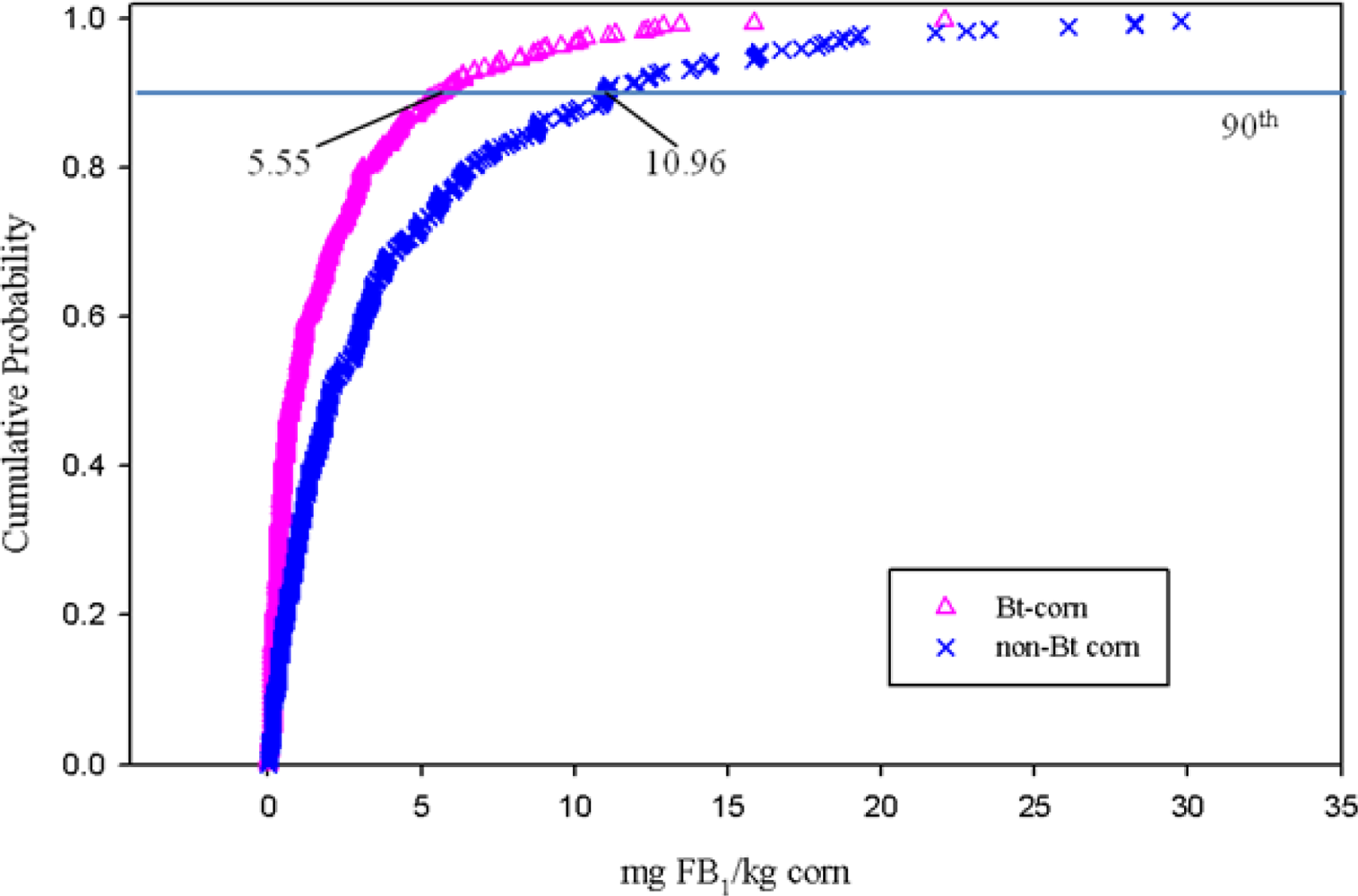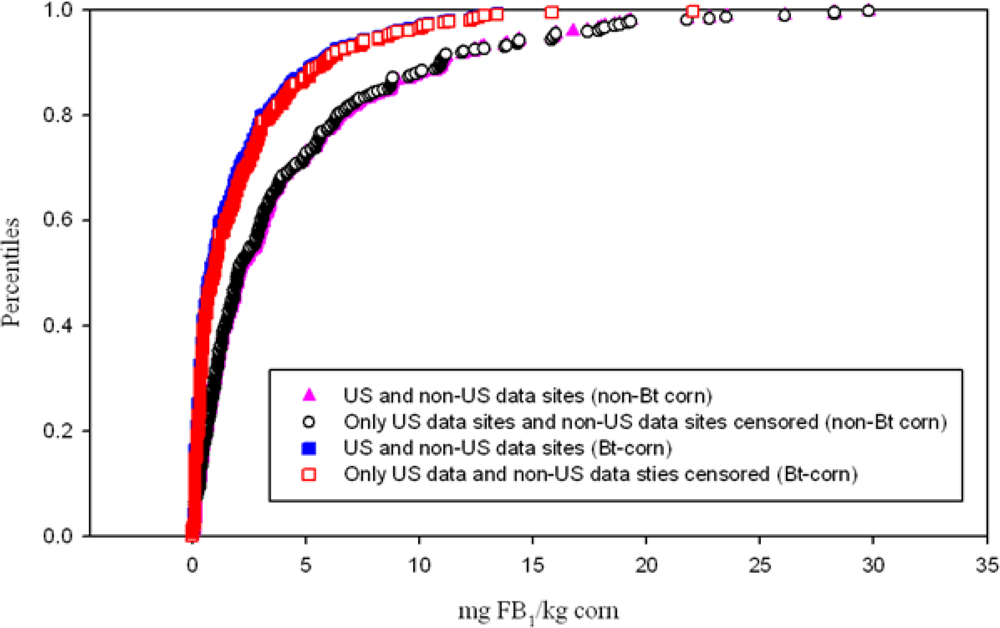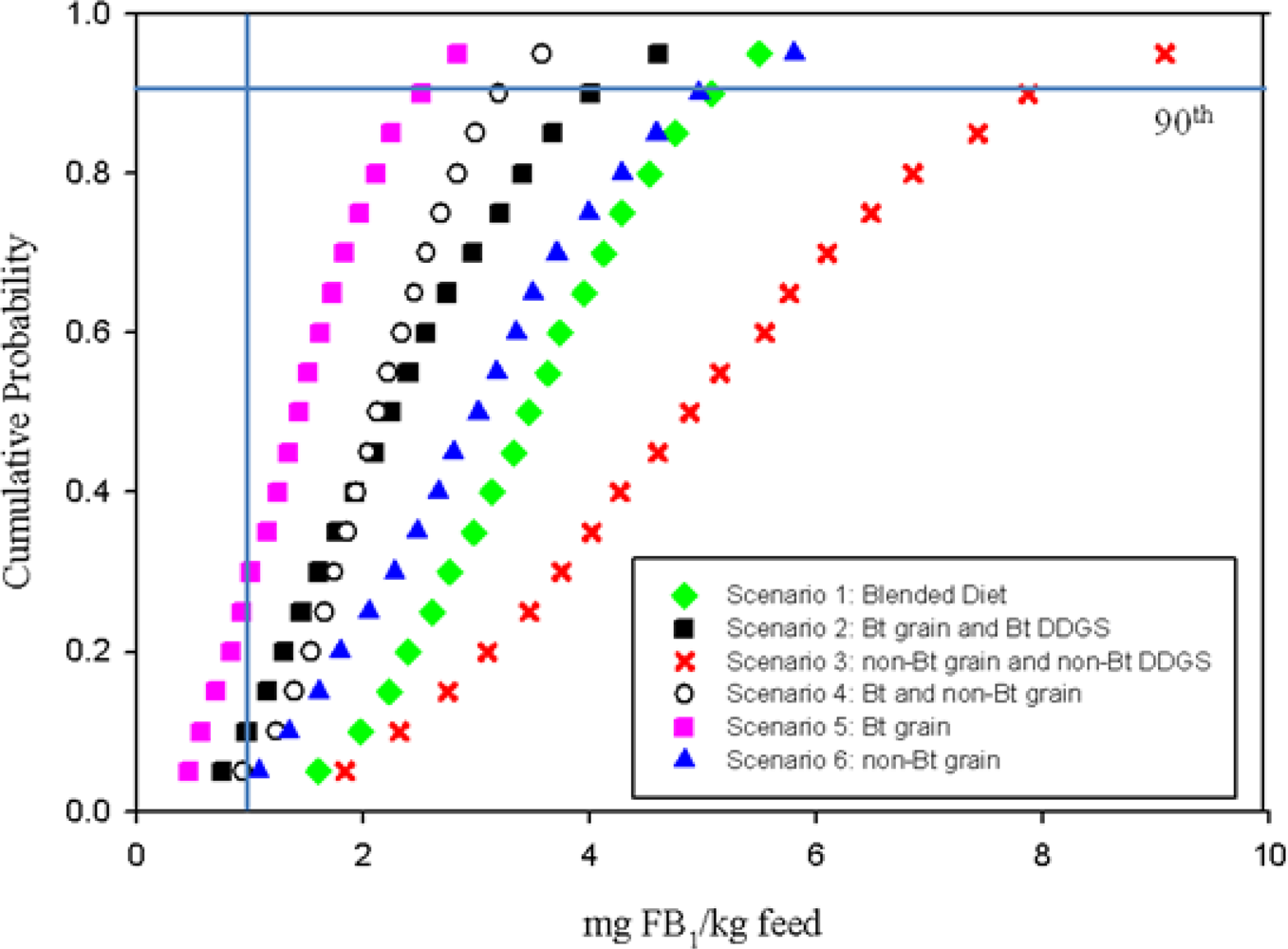Fumonisin B1 Toxicity in Grower-Finisher Pigs: A Comparative Analysis of Genetically Engineered Bt Corn and non-Bt Corn by Using Quantitative Dietary Exposure Assessment Modeling
Abstract
:1. Introduction
2. Materials and Methods
2.1. Analytical Model
- Scenario 1: Blended diet (Bt grain, non-Bt grain, Bt-DDGS and non-Bt DDGS)
- Scenario 2: Bt grain and Bt DDGS
- Scenario 3: non-Bt grain and non-Bt DDGS
- Scenario 4: Bt and non-Bt grain
- Scenario 5: Bt grain
- Scenario 6: non-Bt grain
2.2. Exposure Characterization and Model Parameterization
2.3. Agronomic Management
2.4. Effects Characterization
3. Results
3.1. Deterministic Results
3.2. Semi-Stochastic Results
- Scenario 1: Blended diet (95% of occasions)
- Scenario 2: Bt-grain and Bt DDGS (85% of occasions)
- Scenario 3: non-Bt and non-Bt DDGS (95% of occasions)
- Scenario 4: Bt-grain and non-Bt grain (90% of occasions)
- Scenario 5: Bt grain (70% of occasions)
- Scenario 6: non-Bt grain (95% of occasions)
4. Discussion
Uncertainties in Assessment
Acknowledgments
References
- Frisvad, JC; Thrane, U; Samson, RA; Pitt, JI. Important mycotoxins and the fungi which produce them. Adv. Food Mycol 2006, 571, 3–31. [Google Scholar]
- Haschek, WM; Gumprecht, LA; Smith, G; Tumbleson, ME; Constable, PD. Fumonisin toxicosis in swine: An overview of porcine pulmonary edema and current perspectives. Environ. Health Perspect 2001, 109, 251–257. [Google Scholar]
- Wu, F; Munkvold, GP. Mycotoxins in ethanol co-products: Modeling economic impacts on the livestock industry and management strategies. J. Agr. Food Chem 2008, 56, 3900–3911. [Google Scholar]
- Delgado, JE; Wolt, JD. Fumonisin B1 and implications in nursery swine productivity: A quantitative exposure assessment. J. Anim. Sci 2010, 88, 3767–3777. [Google Scholar]
- Rossi, F; Morlacchini, M; Fusconi, G; Pietri, A; Piva, G. Effect of insertion of Bt gene in corn and different fumonisin content on growth performance of weaned piglets. Ital. J. Anim. Sci 2011, 10, 95–100. [Google Scholar]
- Cullen, AC; Frey, HC. Probabilistic Techniques in Exposure Assessment: A Handbook for Dealing with Variability and Uncertainty in Models and Inputs; Plenum Press: New York, NY, USA, 1999; p. 39. [Google Scholar]
- Goodband, RD. Kansas State University: Manhattan, KS, USA, personal communication, 2008.
- Stein, HH; Shurson, GC. BOARD-INVITED REVIEW: The use and application of distillers dried grains with solubles in swine diets. J. Anim. Sci 2009, 87, 1292–1303. [Google Scholar]
- DeRouchey, JM; Tokach, MD; Dritz, SS; Goodband, RD; Nelssen, JL. Growing-Finishing Pig Recommendations, MF2300; Kansas State University Agriculture Experiment Station and Cooperative Extension Service: Manhattan, NY, USA, 2007. [Google Scholar]
- USDA. Adoption of Genetically Engineered Crops in the U.S: Corn Varieties; Economic Research Service: Washingtong, DC, USA, 2010; Available online: http://www.ers.usda.gov/data/biotechcrops/ExtentofAdoptionTable1.htm (accessed on 22 July 2011).
- Munkvold, GP; Hellmich, RL; Showers, WB. Reduced Fusarium ear rot and symptomless infection in kernels of maize genetically engineered for European corn borer resistance. Phytopathology 1997, 87, 1071–1077. [Google Scholar]
- Munkvold, GP; Hellmich, RL. Genetically modified insect resistant maize implications for management of ear and stalk disease. Plant Health Progr 2000. [Google Scholar] [CrossRef]
- Dowd, PF. Biotic and abiotic factors limiting efficacy of Bt corn in indirectly reducing mycotoxin levels in commercial fields. J. Econ. Entomol 2001, 94, 1067–1074. [Google Scholar]
- Bakan, B; Melcion, D; Richard-Molard, D; Cahagnier, B. Fungal growth and Fusarium mycotoxin content in isogenic traditional maize and genetically modified maize grown in France and Spain. J. Agr. Food Chem 2002, 50, 728–731. [Google Scholar]
- Magg, T; Melchinger, AE; Klein, D; Bohn, M. Relationship between European corn borer resistance and concentration of mycotoxins produced by Fusarium spp. in grains of transgenic Bt maize hybrids, their isogenic counterparts, and commercial varieties. Plant Breed 2002, 121, 146–154. [Google Scholar]
- Clements, MJ; Campbell, KW; Maragos, CM; Pilcher, C; Headrick, JM; Pataky, JK; White, DG. Influence of Cry1Ab protein and hybrid genotype on fumonisin contamination and Fusarium ear rot of corn. Crop Sci 2003, 43, 1283–1293. [Google Scholar]
- Hammond, BG; Campbell, KW; Pilcher, CD; Degooyer, TA; Robinson, AE; McMillen, BL; Spangler, SM; Riordan, SG; Rice, LG; Richard, JL. Lower fumonisin mycotoxin levels in the grain of Bt corn grown in the United States in 2000−2002. J. Agr. Food Chem 2004, 52, 1390–1397. [Google Scholar]
- Tatli, F; Gullu, M; Ozdemir, F. Determination of fungi species, relationship between ear infection rates and fumonisin quantities in Bt maize. IOBC/WPRS Bull 2004, 27, 161–164. [Google Scholar]
- De la Campa, R; Hooker, DC; Miller, JD; Schaafsma, AW; Hammond, BG. Modeling effects of environment, insect damage, and Bt genotypes on fumonisin accumulation in maize in Argentina and the Philippines. Mycopathologia 2005, 159, 539–552. [Google Scholar]
- Papst, C; Utz, HF; Melchinger, AE; Eder, J; Magg, T; Klein, D; Bohn, M. Mycotoxins produced by Fusarium spp. in isogenic Bt vs. non-Bt maize hybrids under European corn borer pressure. Agron. J 2005, 97, 219–224. [Google Scholar]
- Catangui, MA; Berg, RK. Western Bean Cutworm, Striacosta albicosta (Smith) (Lepidoptera: Noctuidae), as a potential pest of transgenic Cry1Ab Bacillus thuringiensis corn hybrids in south Dakota. Environ. Entomol 2006, 35, 1439–1452. [Google Scholar]
- Rotter, BA; Prelusky, DB; Fortin, A; Miller, JD; Savard, ME. Impact of pure fumonisin B-1 on various metabolic parameters and carcass quality of growing-finishing swine—Preliminary findings. Can. J. Anim. Sci 1997, 77, 465–470. [Google Scholar]
- Jouany, JP. Methods for preventing, decontaminating and minimizing the toxicity of mycotoxins in feeds. Anim. Feed. Sci.Technol 2007, 137, 342–362. [Google Scholar]
- Maiorano, A; Reyneri, A; Sacco, D; Magni, A; Ramponi, C. A dynamic risk assessment model (FUMA grain) of fumonisin synthesis by Fusarium verticillioides in maize grain in Italy. Crop Protect 2009, 28, 243–256. [Google Scholar]
- Munkvold, GP; Bilsten, E. Iowa State University: Ames, IA, USA, personal communication, 2011.



| Input Parameter | Deterministic | Semi-stochastic | ||
|---|---|---|---|---|
| Value | Rationale | Distribution | Parameters | |
| Specific Week in Grower-Finisher | Discrete | range: 1 to 20 | ||
| Phase, (week, wk)2 | 10.00 | midpoint | Uniform | |
| Body Weight2, kg | 79.4 | FICC2 | BW = f(wk) | FICC2 |
| Bt Use Fraction, (BUF)3 | 0.76 | maximum | Generalized | min = 0.47 |
| Beta4 | max = 0.69 | |||
| mean = 0.57 | ||||
| mode = 0.49 | ||||
| p = 1.02 | ||||
| q = 1.23 | ||||
| DDGS Use Fraction, (DUF)5 | 0.30 | maximum | maximum | |
| Total corn intake fraction (TCIF), kg corn/kg diet6 | 0.820 | TCIF=f(BW) | TCIF = f(BW) | |
| Fumonisin B1 concentration in Bt grain, mg FB1/kg corn, ([FB1]Bt) | 2.05 | arithmetic mean | empirical CDF7 | min = 0.01 |
| 1% = 0.02 | ||||
| 5% = 0.11 | ||||
| 10% = 0.14 | ||||
| 25% = 0.28 | ||||
| 50% = 0.85 | ||||
| 75% = 2.69 | ||||
| 90% = 5.59 | ||||
| 95% = 8.22 | ||||
| 99% = 13.43 | ||||
| max = 22.50 | ||||
| Fumonisin B1 concentration in non-Bt grain, mg FB1/kg corn, ([FB1]non-Bt) | 4.15 | arithmetic mean | empirical CDF7 | min = 0.00 |
| 1% = 0.05 | ||||
| 5% = 0.14 | ||||
| 10% = 0.28 | ||||
| 25% = 0.78 | ||||
| 50% = 2.05 | ||||
| 75% = 5.59 | ||||
| 90% = 11.03 | ||||
| 95% = 15.91 | ||||
| 99% = 28.28 | ||||
| max = 54.45 | ||||
| DDGS Concentration Factor (DCF)8 | 3.00 | fixed | fixed | |
| Week | Weight, kg | Week | Weight, Kg | Portioned Weekly Timeframes | TCIF2 |
|---|---|---|---|---|---|
| 1 | 27.2 | 11 | 85.5 | Weeks 1 and 2 | 0.685 |
| 2 | 32.4 | 12 | 91.5 | Weeks 3, 4, and 5 | 0.734 |
| 3 | 37.8 | 13 | 97.3 | Weeks 6, 7, and 8 | 0.783 |
| 4 | 43.7 | 14 | 103.1 | Weeks 9, 10, and 11 | 0.820 |
| 5 | 49.2 | 15 | 108.6 | Weeks 12, 13, and 14 | 0.844 |
| 6 | 55.1 | 16 | 113.9 | Weeks 15, 16, 17, 18, 19 and 20 | 0.864 |
| 7 | 61.1 | 17 | 118.9 | ||
| 8 | 67.2 | 18 | 123.7 | ||
| 9 | 73.3 | 19 | 128.2 | ||
| 10 | 79.4 | 20 | 132.4 |
| Weight Ranges, kg | TCIF |
|---|---|
| 22.7 to 33.6 | 0.685 |
| 34.0 to 54.0 | 0.734 |
| 54.4 to 72.1 | 0.783 |
| 72.6 to 88.0 | 0.820 |
| 88.5 to 104.0 | 0.844 |
| >104.3 | 0.864 |
| State | % Insect-resistant Bt only | % Stacked genes varities | % Insect-resistant Bt only + % Stacked Gene Varieties | Fraction of insect-resistant Bt only + stacked gene varieties |
|---|---|---|---|---|
| Illinois | 15 | 52 | 67 | 0.67 |
| Indiana | 7 | 56 | 63 | 0.63 |
| Iowa | 15 | 61 | 76 | 0.76 |
| Kansas | 22 | 40 | 62 | 0.62 |
| Michigan | 11 | 44 | 55 | 0.55 |
| Minnesota | 18 | 46 | 64 | 0.64 |
| Missouri | 15 | 45 | 60 | 0.60 |
| Nebraska | 22 | 45 | 67 | 0.67 |
| North Dakota | 22 | 37 | 59 | 0.59 |
| Ohio | 13 | 36 | 49 | 0.49 |
| South Dakota | 6 | 60 | 66 | 0.66 |
| Texas | 18 | 40 | 58 | 0.58 |
| Wisconsin | 13 | 38 | 51 | 0.51 |
| Generalized β parameters2 | ||||
| Mean = μ | 0.61 | |||
| Mode = c | 0.67 | |||
| Maximum = b | 0.76 | |||
| Minimum = a | 0.49 | |||
| p = α1 | 0.67 | |||
| q = α1 | 0.83 | |||
| Feeding Scenarios1 | Deterministic exposures mg FB1/kg diet | Semi-stochastic exposures mg of FB1/kg of diet | ||
|---|---|---|---|---|
| Median | Mean | 90th | ||
| Scenario 1: Blended Diet2 | 2.86 | 3.46 | 3.50 | 5.08 |
| Scenario 2: Bt grain & Bt DDGS | 2.32 | 2.25 | 2.40 | 4.01 |
| Scenario 3: non-Bt grain & non-Bt DDGS | 4.69 | 4.88 | 5.08 | 7.87 |
| Scenario 4: Bt & non-Bt grain | 2.09 | 2.13 | 2.19 | 3.20 |
| Scenario 5: Bt grain | 1.68 | 1.43 | 1.50 | 2.52 |
| Scenario 6: non-Bt grain | 3.40 | 3.02 | 3.11 | 4.97 |
© 2011 by the authors; licensee MDPI, Basel, Switzerland. This article is an open-access article distributed under the terms and conditions of the Creative Commons Attribution license (http://creativecommons.org/licenses/by/3.0/).
Share and Cite
Delgado, J.E.; Wolt, J.D. Fumonisin B1 Toxicity in Grower-Finisher Pigs: A Comparative Analysis of Genetically Engineered Bt Corn and non-Bt Corn by Using Quantitative Dietary Exposure Assessment Modeling. Int. J. Environ. Res. Public Health 2011, 8, 3179-3190. https://doi.org/10.3390/ijerph8083179
Delgado JE, Wolt JD. Fumonisin B1 Toxicity in Grower-Finisher Pigs: A Comparative Analysis of Genetically Engineered Bt Corn and non-Bt Corn by Using Quantitative Dietary Exposure Assessment Modeling. International Journal of Environmental Research and Public Health. 2011; 8(8):3179-3190. https://doi.org/10.3390/ijerph8083179
Chicago/Turabian StyleDelgado, James E., and Jeffrey D. Wolt. 2011. "Fumonisin B1 Toxicity in Grower-Finisher Pigs: A Comparative Analysis of Genetically Engineered Bt Corn and non-Bt Corn by Using Quantitative Dietary Exposure Assessment Modeling" International Journal of Environmental Research and Public Health 8, no. 8: 3179-3190. https://doi.org/10.3390/ijerph8083179




